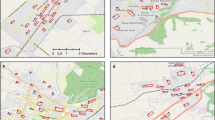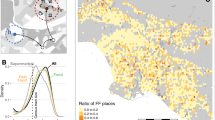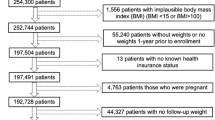Fast food outlets, physical activity facilities, and obesity among adults: a nationwide longitudinal study from Sweden
While neighborhood deprivation is a well-known predictor of obesity, the mechanisms behind this association are unclear and these are important to clarify before designing interventions focusing on modifiable neighborhood environmental factors in order to reduce obesity risk.
Objectives
This study examined the longitudinal association between availability of fast-food outlets and physical activity facilities and the risk of obesity among adults.
Methods
This study used multiple national register data from Sweden. During the 11-year follow-up period between 2005 and 2015, data from 1,167,449 men and 542,606 women, aged 20–55 years, were accessible for inclusion in this analysis. Incidence of obesity was identified based on a diagnosis of obesity during the follow-up period derived from clinical register data. Neighborhood availability of fast-food outlets and physical activity facilities were assessed in 2005 and Cox regression was used in the statistical analysis. Individual socio-demographic factors and neighborhood deprivation were used as covariates.
Results
There were no meaningful associations between neighborhood fast-food outlets or physical activity facilities and obesity in men or women. Neighborhood deprivation was, however, consistently and strongly associated with incidence of obesity in both men and women.
Conclusions
Availability of fast-food outlets and lack of physical activity facilities appear unlikely to cause obesity in Swedish adults. Other potentially modifiable environmental factors within specific social and cultural settings that may influence obesity risk should be examined in future studies.
This is a preview of subscription content, access via your institution
Access options
Subscribe to this journal
Receive 12 print issues and online access
265,23 € per year
only 22,10 € per issue
Buy this article
- Purchase on SpringerLink
- Instant access to full article PDF
Prices may be subject to local taxes which are calculated during checkout
Similar content being viewed by others

Attributes of the food and physical activity built environments from the Southern Cone of Latin America
Article Open access 01 November 2021

Effect of mobile food environments on fast food visits
Article Open access 14 March 2024

Differential associations of the built environment on weight gain by sex and race/ethnicity but not age
Article 27 August 2021
References
- Swinburn BA, Sacks G, Hall KD, McPherson K, Finegood DT, Moodie ML, et al. The global obesity pandemic: shaped by global drivers and local environments. Lancet. 2011;378:804–14. PubMedGoogle Scholar
- Finucane MM, Stevens GA, Cowan MJ, Danaei G, Lin JK, Paciorek CJ, et al. National, regional, and global trends in body-mass index since 1980: systematic analysis of health examination surveys and epidemiological studies with 960 country-years and 9·1 million participants. Lancet. 2011;377:557–67. PubMedPubMed CentralGoogle Scholar
- Must A, Spadano J, Coakley EH, Field AE, Colditz G, Dietz WH. The disease burden associated with overweight and obesity. JAMA. 1999;282:1523–9. CASPubMedGoogle Scholar
- Lim SS, Vos T, Flaxman AD, Danaei G, Shibuya K, Adair-Rohani H, et al. A comparative risk assessment of burden of disease and injury attributable to 67 risk factors and risk factor clusters in 21 regions, 1990–2010: a systematic analysis for the Global Burden of Disease Study 2010. Lancet. 2012;380:2224–60. PubMedPubMed CentralGoogle Scholar
- Garrow JS. Energy balance and obesity in man. 2nd ed. New York; Amsterdam: Elsevier/North-Holland Biomedical Press; 1978. p. 243. completely rev, sole distributors for the U.S.A. and Canada Elsevier North-Holland.
- Stunkard AJ, Foch TT, Hrubec Z. A twin study of human obesity. JAMA. 1986;256:51–4. CASPubMedGoogle Scholar
- Stunkard AJ, Sørensen TI, Hanis C, Teasdale TW, Chakraborty R, Schull WJ, et al. An adoption study of human obesity. N Engl J Med. 1986;314:193–8. CASPubMedGoogle Scholar
- Sobal J, Stunkard AJ. Socioeconomic status and obesity: a review of the literature. Psychol Bull. 1989;105:260–75. CASPubMedGoogle Scholar
- Ball K, Crawford D. Socioeconomic status and weight change in adults: a review. Soc Sci Med. 2005;60:1987–2010. PubMedGoogle Scholar
- McLaren L. Socioeconomic status and obesity. Epidemiol Rev. 2007;29:29–48. PubMedGoogle Scholar
- Garner DM, Wooley SC. Confronting the failure of behavioral and dietary treatments for obesity. Clin Psychol Rev. 1991;11:729–80. Google Scholar
- Gill TP. Key issues in the prevention of obesity. Br Med Bull. 1997;53:359–88. CASPubMedGoogle Scholar
- Egger G, Swinburn B. An “ecological” approach to the obesity pandemic. BMJ. 1997;315:477–80. CASPubMedPubMed CentralGoogle Scholar
- Pickett KE, Pearl M. Multilevel analyses of neighbourhood socioeconomic context and health outcomes: a critical review. J Epidemiol Community Health. 2001;55:111–22. CASPubMedPubMed CentralGoogle Scholar
- McLeroy KR, Bibeau D, Steckler A, Glanz K. An ecological perspective on health promotion programs. Health Educ Q. 1988;15:351–77. CASPubMedGoogle Scholar
- Stafford M, Cummins S, Ellaway A, Sacker A, Wiggins RD, Macintyre S. Pathways to obesity: identifying local, modifiable determinants of physical activity and diet. Soc Sci Med. 2007;65:1882–97. PubMedGoogle Scholar
- Mason KE, Pearce N, Cummins S. Associations between fast food and physical activity environments and adiposity in mid-life: cross-sectional, observational evidence from UK Biobank. Lancet Public Health. 2018;3:e24–33. PubMedGoogle Scholar
- Mackenbach JD, Rutter H, Compernolle S, Glonti K, Oppert J-M, Charreire H, et al. Obesogenic environments: a systematic review of the association between the physical environment and adult weight status, the SPOTLIGHT project. BMC Public Health. 2014;14:223. Google Scholar
- Papas MA, Alberg AJ, Ewing R, Helzlsouer KJ, Gary TL, Klassen AC. The built environment and obesity. Epidemiol Rev. 2007;29:129–43. PubMedGoogle Scholar
- Ng M, Fleming T, Robinson M, Thomson B, Graetz N, Margono C, et al. Global, regional, and national prevalence of overweight and obesity in children and adults during 1980-2013: a systematic analysis for the Global Burden of Disease Study 2013. Lancet. 2014;384:766–81. PubMedPubMed CentralGoogle Scholar
- Gortmaker SL, Swinburn B, Levy D, Carter R, Mabry PL, Finegood D, et al. Changing the future of obesity: science, policy and action. Lancet. 2011;378:838–47. PubMedPubMed CentralGoogle Scholar
- Sundquist K, Malmström M, Johansson S-E. Neighbourhood deprivation and incidence of coronary heart disease: a multilevel study of 2.6 million women and men in Sweden. J Epidemiol Community Health. 2004;58:71–7. CASPubMedPubMed CentralGoogle Scholar
- Sundquist K, Winkleby M, Ahlén H, Johansson S-E. Neighborhood socioeconomic environment and incidence of coronary heart disease: a follow-up study of 25,319 women and men in Sweden. Am J Epidemiol. 2004;159:655–62. PubMedGoogle Scholar
- Hamano T, Li X, Sundquist J, Sundquist K. Association between childhood obesity and neighbourhood accessibility to fast-food outlets: a nationwide 6-year follow-up study of 944,487 children. OFA. 2017;10:559–68. Google Scholar
- Kawakami N, Li X, Sundquist K. Health-promoting and health-damaging neighbourhood resources and coronary heart disease: a follow-up study of 2 165 000 people. J Epidemiol Community Health. 2011;65:866–72. PubMedGoogle Scholar
- Winkleby M, Sundquist K, Cubbin C. Inequities in CHD Incidence and case fatality by neighborhood deprivation. Am J Prev Med. 2007;32:97–106. PubMedPubMed CentralGoogle Scholar
- Gilthorpe MS. The importance of normalisation in the construction of deprivation indices. J Epidemiol Community Health. 1995;49(Suppl 2):S45–50. PubMedPubMed CentralGoogle Scholar
- Kawakami N, Winkleby M, Skog L, Szulkin R, Sundquist K. Differences in neighborhood accessibility to health-related resources: a nationwide comparison between deprived and affluent neighborhoods in Sweden. Health Place. 2011;17:132–9. PubMedGoogle Scholar
- Larson NI, Story MT, Nelson MC. Neighborhood environments. Am J Prev Med. 2009;36:74–81.e10. PubMedGoogle Scholar
- Cummins S, Macintyre S. “Food deserts”—evidence and assumption in health policy making. BMJ. 2002;325:436–8. PubMedPubMed CentralGoogle Scholar
- Ghosh-Dastidar B, Cohen D, Hunter G, Zenk SN, Huang C, Beckman R, et al. Distance to store, food prices, and obesity in urban food deserts. Am J Prev Med. 2014;47:587–95. PubMedPubMed CentralGoogle Scholar
- Suarez JJ, Isakova T, Anderson CAM, Boulware LE, Wolf M, Scialla JJ. Food access, chronic kidney disease, and hypertension in the U.S. Am J Prev Med. 2015;49:912–20. PubMedPubMed CentralGoogle Scholar
- Clary CM, Ramos Y, Shareck M, Kestens Y. Should we use absolute or relative measures when assessing foodscape exposure in relation to fruit and vegetable intake? Evidence from a wide-scale Canadian study. Prev Med. 2015;71:83–7. PubMedGoogle Scholar
- Mason KE, Bentley RJ, Kavanagh AM. Fruit and vegetable purchasing and the relative density of healthy and unhealthy food stores: evidence from an Australian multilevel study. J Epidemiol Community Health. 2013;67:231–6. PubMedGoogle Scholar
- Drewnowski A, Darmon N. The economics of obesity: dietary energy density and energy cost. Am J Clin Nutr. 2005;82:265S–73S. CASPubMedGoogle Scholar
- Franck C, Grandi SM, Eisenberg MJ. Taxing junk food to counter obesity. Am J Public Health. 2013;103:1949–53. PubMedPubMed CentralGoogle Scholar
- Powell LM, Chaloupka FJ. Food prices and obesity: evidence and policy implications for taxes and subsidies. Milbank Q. 2009;87:229–57. PubMedPubMed CentralGoogle Scholar
- Pearce J, Hiscock R, Blakely T, Witten K. A national study of the association between neighbourhood access to fast-food outlets and the diet and weight of local residents. Health Place. 2009;15:193–7. PubMedGoogle Scholar
- Ellaway A, Lamb KE, Ferguson NS, Ogilvie D. Associations between access to recreational physical activity facilities and body mass index in Scottish adults. BMC Public Health. 2016;16:756. PubMedPubMed CentralGoogle Scholar
- Sundquist K, Eriksson U, Kawakami N, Skog L, Ohlsson H, Arvidsson D. Neighborhood walkability, physical activity, and walking behavior: The Swedish Neighborhood and Physical Activity (SNAP) study. Soc Sci Med. 2011;72:1266–73. PubMedGoogle Scholar
- Pearce J, Witten K, Hiscock R, Blakely T. Are socially disadvantaged neighbourhoods deprived of health-related community resources? Int J Epidemiol. 2007;36:348–55. PubMedGoogle Scholar
- Macintyre S, Macdonald L, Ellaway A. Do poorer people have poorer access to local resources and facilities? The distribution of local resources by area deprivation in Glasgow, Scotland. Soc Sci Med 2008;67:900–14. PubMedPubMed CentralGoogle Scholar
- Christakis NA, Fowler JH. The spread of obesity in a large social network over 32 years. N Engl J Med. 2007;357:370–9. CASPubMedGoogle Scholar
- Pettersson J, Johansson K, Rössner S, Neovius M. Prevalence of obesity and abdominal obesity in Swedish primary care and occupational health clinics. Obes Facts. 2008;1:251–7. PubMedPubMed CentralGoogle Scholar
- Puhl RM, Andreyeva T, Brownell KD. Perceptions of weight discrimination: prevalence and comparison to race and gender discrimination in America. Int J Obes. 2008;32:992–1000. CASGoogle Scholar
- Lissner L, Johansson S-E, Qvist J, Rössner S, Wolk A. Social mapping of the obesity epidemic in Sweden. Int J Obes. 2000;24:801–5. CASGoogle Scholar
- Sundquist K, Qvist J, Johansson S-E, Sundquist J. Increasing trends of obesity in Sweden between 1996/97 and 2000/01. Int J Obes. 2004;28:254–61. CASGoogle Scholar
- Neovius M, Janson A, Rössner S. Prevalence of obesity in Sweden. Obes Rev Off J Int Assoc Study Obes. 2006;7:1–3. CASGoogle Scholar
Acknowledgements
This Research was supported by the Swedish Heart-Lung Foundation, the Swedish Research Council, and ALF funding from Region Skåne to Kristina Sundquist.
Author information
Authors and Affiliations
- Center for Primary Health Care Research, Lund University, Malmö, Sweden Kenta Okuyama, Xinjun Li & Kristina Sundquist
- Center for Community-based Healthcare Research and Education, Shimane University, Shimane, Japan Kenta Okuyama, Takafumi Abe, Tsuyoshi Hamano, Toru Nabika & Kristina Sundquist
- Department of Sports Sociology and Health Sciences, Faculty of Sociology, Kyoto Sangyo University, Kyoto, Japan Tsuyoshi Hamano
- Department of Clinical Sciences, Genetic and Molecular Epidemiology Unit, Lund University, Malmö, Sweden Paul W. Franks
- Department of Functional Pathology, Shimane University School of Medicine, Izumo, Japan Toru Nabika
- Department of Family Medicine and Community Health, Department of Population Health Science and Policy, Icahn School of Medicine at Mount Sinai, New York, NY, USA Kristina Sundquist
- Kenta Okuyama




